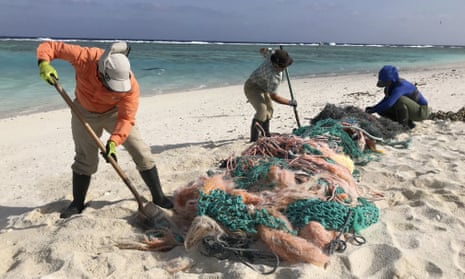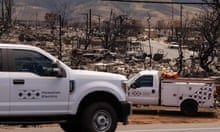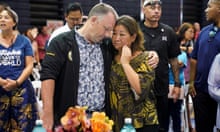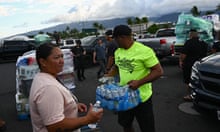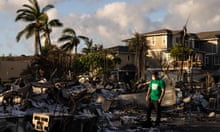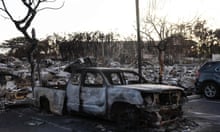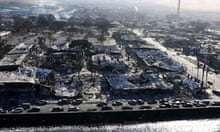In February, just as the coronavirus pandemic began to take hold, four people set sail for one of the most remote places on Earth — a small camp on Kure Atoll, at the edge of the uninhabited Northwestern Hawaiian Islands.
There, more than 2,200km from Honolulu, they lived in isolation for nearly nine months while working to restore the island’s environment.
Cut off from the rest of the planet, their world was limited to a tiny patch of sand halfway between the US mainland and Asia. With no television or internet access, their only information came from satellite text messages and occasional emails.
They learned about the pandemic amid their own isolation, but have not experienced any of the seismic upheaval the Covid-19 virus has wrought around the world.
Now they are back, re-emerging into changed societies that might feel as foreign today as island isolation did in March.
They must adjust to wearing face masks, staying indoors and seeing friends without giving hugs or handshakes.
“I’ve never seen anything like this, but I started reading the book The Stand by Stephen King, which is about a disease outbreak, and I was thinking, ‘Oh my goodness, is this what it’s going to be like to go home?’” said Charlie Thomas, one of the four island workers. “All these … precautions, these things, people sick everywhere. It was very strange to think about.”
The group was part of an effort by the state of Hawaii to maintain the fragile island ecosystem on Kure, which is part of the Papahanaumokuakea Marine National Monument, the nation’s largest contiguous protected environment. The public is not allowed to land anywhere in the Northwestern Hawaiian Islands.

Kure is the only island in the northern part of the archipelago that is managed by the state, with the rest under the jurisdiction of the federal government. A former Coast Guard station, the atoll is home to seabirds, endangered Hawaiian monk seals and coral reefs that are teeming with sea turtles, tiger sharks and other marine life.
Two field teams go there each year, one for summer and another for winter. Their primary job is removing invasive plants and replacing them with native species and cleaning up debris such as fishing nets and plastic that washes ashore.
Thomas, the youngest member of the team at 18, grew up in a beach town in New Zealand and spent much of her free time with seabirds and other wildlife. She finished school a year early to start her first job as a deckhand for an organisation dedicated to cleaning up coastlines before volunteering for the summer season on Kure Atoll.
The expedition was her first time being away from home for so long, but she was ready to disconnect.
“I was sick of social media, I was sick of everything that was sort of going on,” she said. “And I thought, you know, I am so excited to get rid of my phone, to lose contact with everything ... I don’t need to see all the horrible things that are going on right now.”
When Thomas left New Zealand for Hawaii, there were no virus cases nearby that she can recall. By the time she left Honolulu for Kure, the virus was starting to “creep a little closer” to the islands.
“We were just seeing stories on the television and that sort of thing,” she said. “But, you know, we’re off. We’re leaving. It wasn’t really a big concern for us.”
Once on Kure, getting a full picture of what was happening in the world was difficult.
“I guess I didn’t really know what to think because we were getting so many different answers to questions that we were asking,” she said.
Thomas is now in a hotel in quarantine in Auckland, where she lives with her parents, sister and a dog named Benny. She will miss hugs and “squishing five people on a bench to have dinner,” she said.
American Matthew Butschek, who was also on Kure, said it would take time to adjust to the changed world they’d returned to.
In quarantine, he looked out the window of his cabin in Honolulu and saw school-aged children playing on rocks and climbing trees — all wearing face masks. It reminded him of apocalyptic movies.
“It’s not normal for me. But everyone is like, yeah, this is what we do now. This is how we live,” he said.

Aided by geographic isolation and swiftly and resolutely closed borders, the Pacific has remained the least-infected region on earth. But the enforced isolation has devastated Pacific economies.
But there are significant fears if the virus were to gain a foothold in the region, it could devastate island communities, which have limited public health infrastructure – Vanuatu began the pandemic with only two ventilators in the entire country - and populations with high rates of comorbidities, such as diabetes and heart disease.
Most of the remaining Covid-free nations on earth are in the Pacific, but these are beginning to dwindle, as repatriation flights bring home stranded citizens. In the last month, Vanuatu, Solomon Islands, Marshall Islands, and Samoa have recorded their first confirmed infections.
Other Pacific islands, such as Guam and French Polynesia, have had large numbers of cases seeded by military and police deployments from colonial powers the US and France.
The small and remote island nations and territories of Kiribati, Micronesia, Nauru, Palau, Tonga, Tuvalu, Cook Islands, Niue, Tokelau, Norfolk island and Pitcairn island are believed to be still free of the virus.
with Associated Press
